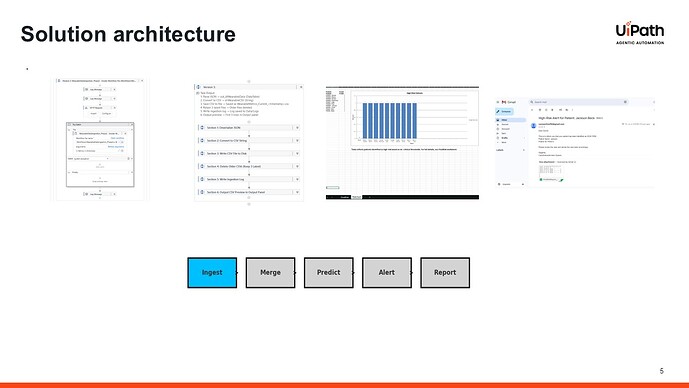AgentHack submission type
Enterprise Agents
Name
Roopa Patel – Product Owner & RPA Developer, Technovashield
Team name
Technovashield – CareSentinelAI
Team members
Roopa Patel
How many agents do you use
One agent
Industry category in which use case would best fit in (Select up to 2 industries)
Healthcare Pharma
Information technology and services
Complexity level
Advanced
Summary (abstract)
CareSentinelAI is an enterprise-grade predictive health risk management system that uses an intelligent agent to analyze patient metrics and flag high-risk individuals. Built with UiPath Studio, Maestro, and AI Center, this agent not only classifies patient risk levels but also sends real-time alerts to doctors, nurses, and patients. Designed for scalability and future enhancement, CareSentinelAI sets the foundation for a fully automated, proactive healthcare assistant powered by agentic automation
Detailed problem statement
Chronic health conditions often go undetected until serious complications arise, placing significant strain on healthcare systems and reducing patient quality of life. Healthcare providers struggle to monitor patients proactively due to fragmented data, manual workflows, and lack of timely alerts.
The CareSentinelAI project addresses this gap by focusing on early detection of at-risk patients using wearable metrics, lab data, and medical history. The challenge lies in unifying scattered data sources, assessing health risk accurately, and ensuring the right people are notified before emergencies occur.
This automation solution aims to shift healthcare from reactive to preventive — enabling early, AI-powered interventions through a unified decision-making agent.
Detailed solution
CareSentinelAI solves the healthcare risk detection problem through a fully orchestrated, agent-driven automation framework. The core agent is built using UiPath Studio and deployed via UiPath Agent Builder, operating in version 14 of the CareSentinelAI workflow.
The agent performs end-to-end automation that:
Ingests and unifies patient, wearable, and lab data
Trains and applies a predictive risk classification model
Generates a final list of high-risk patients
Sends real-time alerts via email to doctors, nurses, and patients
The project uses UiPath Maestro to manage orchestration. Users must run the Agent:
The CareSentinelAI Agent was successfully configured and executed using UiPath Agent Builder and Maestro. While the agent runs successfully via Maestro and completes all required stages, the Agent Builder UI still shows the “Draft” label even after publishing. This has been reported to UiPath Labs (July 4) and acknowledged as a potential UI sync issue. Functionality and run trace remain unaffected.
Demo Video
Expected impact of this automation
- Reduces manual data review by up to 80% by automating ingestion and risk detection
- Enables near real-time intervention for high-risk patients
- Supports clinical decision-making by notifying doctors, nurses, and patients promptly
- Consolidates fragmented patient data across wearable, lab, and demographic sources
- Improves compliance through traceable alert logs and versioned outputs
- Saves hundreds of staff hours annually in triage and patient monitoring
- Lowers emergency admissions through early AI-powered interventions
- Improves patient outcomes, especially in overburdened public health systems
UiPath products used (select up to 4 items)
UiPath AI Center
UiPath Agent Builder
UiPath Maestro
UiPath Studio
Automation Applications
Email, Google Drive File System, HTTP APIs, Python-based ML Model Execution
Integration with external technologies
Python, Scikit-learn, Pandas, Gmail API, Google Drive API, HTTP APIs, UiPath Copilot (planned integration)
Agentic solution architecture (file size up to 4 MB)
Sample inputs and outputs for solution execution
Inputs (used by the agent at runtime):
- PatientData_Phase2.csv – Includes Name, DOB, Gender, UID
- WearableMetrics_Current_.csv – HeartRate, Steps, SleepHours
- LabResults_Current_.csv – Cholesterol, Glucose, and lab metrics
- RiskClassifier.pkl – Trained ML model for predicting risk scores
Outputs (generated by the agent):
- PatientRiskPredictions_.csv – RiskScore and RiskFlag per patient
- FinalRiskReport_.xlsx – Human-readable report with alerts
- Emails sent to Doctor, Nurse, and Patient with report attachments
- Ingestion and alert logs (saved as TXT/CSV)
- Archived copies of input/output files for traceability
*All file formats are sample-ready and timestamped to reflect real-time execution. Sample versions are included in the Sample Folder under Inputs and Outputs Folder.
Other resources
![]() Module Summaries & Flowcharts (Attached in PDF)
Module Summaries & Flowcharts (Attached in PDF)
- The full solution is structured into 9 tested modules, each aligned with the agentic workflow defined in Point 16.
- Detailed summaries and flowcharts are included in the PDF document:
- “Module Summaries (All Completed & Flowcharts Attached).pdf”
Modules include as Listed Below:
Pdf Document Link:
https://drive.google.com/file/d/1C--0tUcOARN-6JlljwdQi7F4ZqAXvQTX/view?usp=drive_link
Module 1 – PatientDataIngestion_Phase2.xaml: Downloads and logs JSON FHIR data
Module 2 – WearableDataIngestion_Phase2.xaml: Parses JSON, saves CSVs, and logs ingestion
Module 3 – LabResultsIngestion_Phase2.xaml: Fetches and structures lab data including Cholesterol
Module 4 – BuildMasterPatientMetrics.xaml: Merges Patient, Wearable, and Lab data via UID
Module 5 – TrainRiskScoreModel.xaml: Trains ML model, exports .pkl and JSON logs
Module 6 – FinalRiskReport.xaml: Adds RiskFlag and generates final enriched report
Module 7 – EmailAlert.xaml: Sends email alerts with risk summaries to GP, Nurse, Patient
Module 8–9 – SimulateAgentDecision.xaml + SendAlertEmailAgent.xaml: Simulates agent logic, filters high-risk patients, and triggers automated alerts
![]() Access all supporting materials, screenshots, sample files, and the full presentation in this ZIP folder:
Access all supporting materials, screenshots, sample files, and the full presentation in this ZIP folder:
